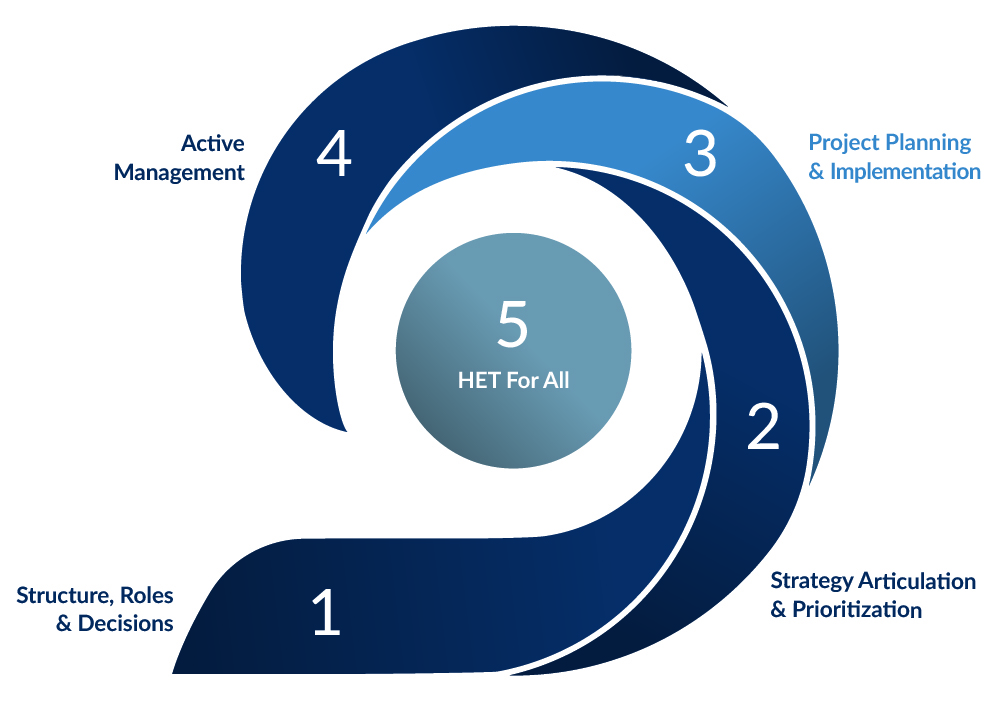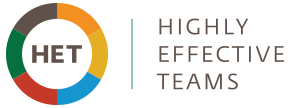
The HET® Framework
HET is for Any Kind of Team
HET is about developing Highly Effective Teams® by using best practices to identify, focus on, and manage our most important work. It is also about helping us enjoy our work more.
The HET Framework is designed as a wave to illustrate the typical path that teams follow in their work together.

The HET Framework covers the five stages of high performance teamwork by offering methods and tools to address the following questions:
1 Module 1: Structure, Roles & Decisions: “How are we organizing ourselves for success, and who makes what decisions?”A new team starts with Structure, Roles & Decisions so that the team members can align on how they fit together in a management hierarchy, who is offering what skills and capacities, and how decisions will be made for transparency and efficiency.
2 Module 2: Strategy Articulation & Prioritization: “For our expected results and outcomes, what is our most important work, and who leads each piece?” Next, the team works on Strategy Articulation & Prioritization in order to define the team’s strategic vision and prioritize and allocate the most important work needed to achieve that vision.
3 Module 3: Project Planning & Implementation: “What do we need to do to succeed on our time-bound projects, and who needs to be involved?” With a common view on the body of work to accomplish, the team then executes the project by using Project Planning & Implementation.
4 Module 4: Active Management: “How do we ensure we deliver the promised work and that it adds up to the change we want to see in the world?” On a regular basis, the team uses Active Management to ensure that the promised work is delivered and that the results of the work are achieving the team’s strategy vision. Usually, this leads the team to continue ‘riding the wave’ of the teamwork cycle by going back to Module 2 to revise or confirm the strategy and body of work. If the Active Management process results in the decision to make major changes, the team may need to ‘enter a new wave’ by going back to Module 1.
5 Module 5: HET® for All: “How do we behave with one another?” HET for All is shown in the middle of the circle because this curriculum includes behaviors and practices that are needed during all other stages of teamwork.
The HET learning curriculum is built around the five HET Modules. Each module includes a set of 3 HET Principles which give you practical methods and ready-to-use tools for the stage of teamwork that you’re in.
What Type of Team Are You?

Strategy Teams
Stable departments or temporary, cross-functional teams working together to articulate and implement a long-term strategy and plan of 3-5 years or longer. Strategy teams manage a portfolio of projects and roles together and may stay together as an intact team as long as the strategy is successful, funded, and needed.
The three colors of the HET Framework represent the methods and tools to support the needs of each audience. The tools can be used alone or together to support specific points in your team’s work, or as an integrated curriculum that supports the full life cycle of high performance teamwork.
HET for Strategies is a more extensive body of knowledge, encompassing three learning modules. HET for Projects and HET for All have one learning module each. Typically, an organization or department needs all five modules over time, but can begin by learning wherever their teamwork improvement needs are most immediate.


